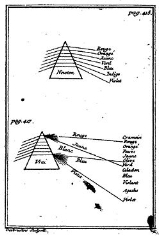
Louis Bertrand Castel
Encyclopedia
Louis Bertrand Castel was a French
mathematician
born in Montpellier
, and entered the order of the Jesuits in 1703. Having studied literature, he afterwards devoted himself entirely to mathematics
and natural philosophy
. He wrote several scientific works, that which attracted most attention at the time being his Optique des couleurs (1740), or treatise on the melody of colors. He also wrote Traité de physique sur la pesanteur universelle des corps (1724), Mathématique universelle (1728), and a critical account of the system of Sir Isaac Newton in 1743.
 It was in 1740 that Louis Bertrand Castel published a criticism of Newton's spectral description of prismatic colour in which he observed that the colours of white light split by a prism depended on the distance from the prism, and that Newton was looking at a special case. It was an argument that Goethe later developed in his Theory of Colours
It was in 1740 that Louis Bertrand Castel published a criticism of Newton's spectral description of prismatic colour in which he observed that the colours of white light split by a prism depended on the distance from the prism, and that Newton was looking at a special case. It was an argument that Goethe later developed in his Theory of Colours
.
went to France
to see Castel's Ocular Harpsichord for himself. He ended up composing several pieces for it, and even wrote a book about it. .
The ocular harpsichord had sixty small coloured glass panes, each with a curtain that opened when a key was struck. A second, improved model of the harpsichord was demonstrated for a small audience in December of 1754. Pressing a key caused a small shaft to open, in turn allowing light to shine through a piece of stained glass. Castel thought of color-music as akin to the lost language of paradise, where all men spoke alike, and he claimed that thanks to his instrument’s capacity to paint sounds, even a deaf listener could enjoy music.
France
The French Republic , The French Republic , The French Republic , (commonly known as France , is a unitary semi-presidential republic in Western Europe with several overseas territories and islands located on other continents and in the Indian, Pacific, and Atlantic oceans. Metropolitan France...
mathematician
Mathematician
A mathematician is a person whose primary area of study is the field of mathematics. Mathematicians are concerned with quantity, structure, space, and change....
born in Montpellier
Montpellier
-Neighbourhoods:Since 2001, Montpellier has been divided into seven official neighbourhoods, themselves divided into sub-neighbourhoods. Each of them possesses a neighbourhood council....
, and entered the order of the Jesuits in 1703. Having studied literature, he afterwards devoted himself entirely to mathematics
Mathematics
Mathematics is the study of quantity, space, structure, and change. Mathematicians seek out patterns and formulate new conjectures. Mathematicians resolve the truth or falsity of conjectures by mathematical proofs, which are arguments sufficient to convince other mathematicians of their validity...
and natural philosophy
Philosophy
Philosophy is the study of general and fundamental problems, such as those connected with existence, knowledge, values, reason, mind, and language. Philosophy is distinguished from other ways of addressing such problems by its critical, generally systematic approach and its reliance on rational...
. He wrote several scientific works, that which attracted most attention at the time being his Optique des couleurs (1740), or treatise on the melody of colors. He also wrote Traité de physique sur la pesanteur universelle des corps (1724), Mathématique universelle (1728), and a critical account of the system of Sir Isaac Newton in 1743.
Work in Optics

Theory of Colours
Theory of Colours is a work by Johann Wolfgang von Goethe about the poet's views on the nature of colours and how these are perceived by man, published in 1810...
.
The Ocular Harpsichord
Early on, Castel illustrated his optical theories with a proposal for a Clavecin pour les yeux (Ocular Harpsichord, 1725). While the treatise and the illustration were apparently forgotten, he continually developed the idea. It was soon after the publication of his L'Optique des couleurs in the 1740s, that German composer TelemannGeorg Philipp Telemann
Georg Philipp Telemann was a German Baroque composer and multi-instrumentalist. Almost completely self-taught in music, he became a composer against his family's wishes. After studying in Magdeburg, Zellerfeld, and Hildesheim, Telemann entered the University of Leipzig to study law, but eventually...
went to France
France
The French Republic , The French Republic , The French Republic , (commonly known as France , is a unitary semi-presidential republic in Western Europe with several overseas territories and islands located on other continents and in the Indian, Pacific, and Atlantic oceans. Metropolitan France...
to see Castel's Ocular Harpsichord for himself. He ended up composing several pieces for it, and even wrote a book about it. .
The ocular harpsichord had sixty small coloured glass panes, each with a curtain that opened when a key was struck. A second, improved model of the harpsichord was demonstrated for a small audience in December of 1754. Pressing a key caused a small shaft to open, in turn allowing light to shine through a piece of stained glass. Castel thought of color-music as akin to the lost language of paradise, where all men spoke alike, and he claimed that thanks to his instrument’s capacity to paint sounds, even a deaf listener could enjoy music.

